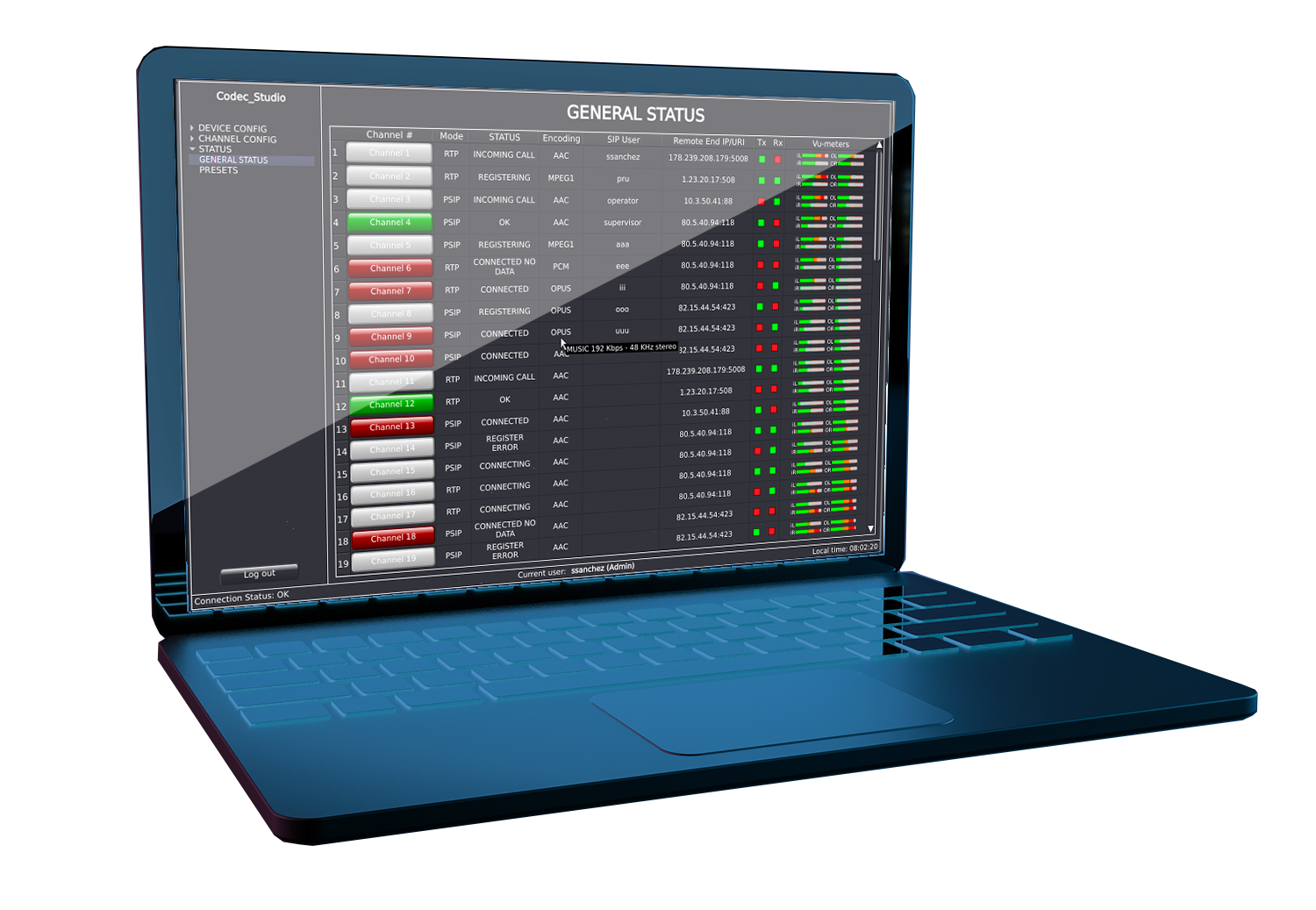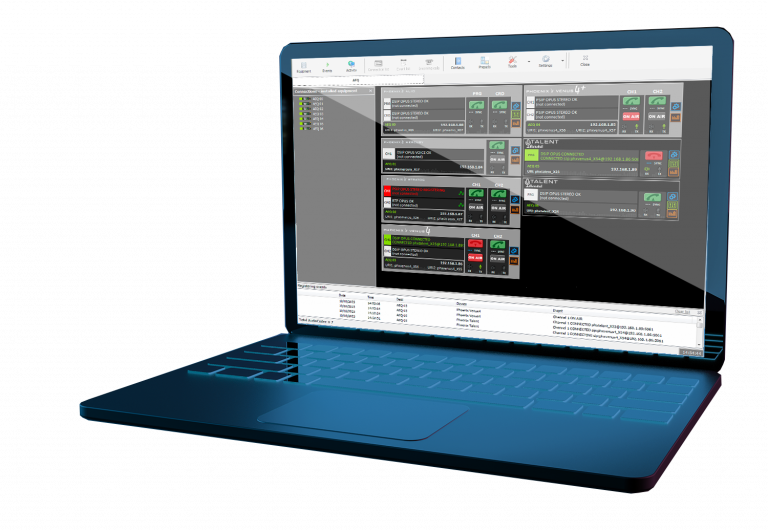
Scalable multiple stereo audiocodec, with IP connectivity. Between 8 and 64 independent connections
IP-only local audio
5 network ports: allow separation of control traffic, encrypted audio (and local audio I/O over IP), and local audio over IP
Compatible with most audiocodecs from other manufacturers
Installable on generic and virtualisable servers
AEQ audiocodes' proprietary communications protocol, ‘Smart RTP’, simplifies connection
High Density Audio Multicodec Gateway
Scalable codec system, available from 8 to a maximum of 64 bi-directional stereo audio codecs, all in a 1UR device. Specially designed for multiple STL links, broadcast chains and remote contributions.

Description
Functional

240×240 TFT colour display showing important information such as network interfaces, power supply, channels in use, …
Button to navigate through the screens

5 network ports (LAN1…LAN5)
2 AC power supplies
- Compatible with most third-party audiocodecs.
- Adaptive buffering to absorb network jitter.
- Automatic configuration of connection parameters.
- 3 network ports: allows separation of control traffic, encrypted audio (WAN) and local audio I/O over IP AES67/Dante.
- Automatic adjustment of the reference clock to synchronise both ends.
- Error correction (FEC).
- Sending to multiple destinations in multiple unicast.
- Can be monitored remotely. Includes SNMP server that allows the use of any standard SNMP client.
- Dual continuous data channel.
- Professional audio analogue, digital and Dante/ AES67 IP option.
- Silent. The unit is cooled by natural convection.
- Possibility of dual AC power supply and/or one or two 48 V DC power inputs.
- DHCP.
Control Software

Solaris Web
This is the specific SOLARIS configuration and control tool that allows the global status of each of the audiocodecs to be easily visualised.
The configuration screen for each channel can be accessed to establish the correspondent and communication parameters. It also incorporates the following functions: ‘call book’ to quickly identify the correspondents and ‘presets’ to save the configuration details of each channel, as well as other tools to configure the equipment in an installation.
Control Phoenix
Control and configure your equipment from your computer. Allows you to remotely configure and operate a fleet of audiocodecs (local or remote).
An optional multicodec application allows to detect all AEQ IP audiocodecs in a local network to control them in a coordinated way from a PC or group of PCs. It also allows remote equipment to be controlled through the Internet, favouring an integral management of the communications network.

Technical details
IP audio inputs / outputs: one stereo input and one stereo output, DANTE / AES67 technology for each activated channel (8 channels, 8 stereo inputs and 8 stereo outputs as standard). 8 by 8 channel expansion, up to a maximum of 64 bidirectional channels with Dante redundancy to two of the 5 built-in 1Gbps RJ45 ports.
Analogue and digital audio inputs / outputs: audio is converted to analogue or digital on other Dante compatible equipment. It can be routed to Interfaces, consoles or matrices.
AEQ Netbox 32AD: interface with 8 stereo analogue/digital AES/EBU stereo e/s gives full analogue or digital connectivity to a SOLARIS as standard.
• Local audio over IP AES67 or Dante formats. Fs 44.1, 48, 88.2 and 96 kHz.
• Distortion at maximum level (encode+decode loop in linear audio): <0.003%.
• Max Latency of Dante configurable: 2, 3, 4, 5 and 10ms.
• Frequency response (+/- 0.2dB): up to 20 Hz- 20 KHz. Depending on coding algorithm.
• OPUS with Fs= 48kHz, mono, stereo, selected 5 mono and 3 stereo modes, with bitrates between 12 and 192 Kbps, very low delay and audio bandwidths between 6 and 20 KHz:
• OPUS Voice (Bw reducido) 12kbps: 6kHz.
• OPUS Voice 20kbps: 8KHz.
• OPUS Voice 192kbps: 8kHz.
• OPUS Music mono (reduced bitrate) 32 kbps: 20kHz.
• OPUS Music mono 64kbps: 20kHz.
• OPUS Music Stereo (reduced bitrate) 64kbps: 20kHz.
• OPUS Music Stereo 128kbps: 20kHz.
• OPUS Music Stereo HQ 192 kbps: 20kHz.
(The receiver is synchronised and can decode the stream received from other OPUS modes sampled at 48 kHz).
• G711 A-law, u-law (64 kbps, low delay, bandwidth 3.5 KHz).
• G722 (64 Kbps, low delay, bandwidth 7 KHz).
• PCM (linear) with very low delay and transparent quality. Fs=48KHz or 32 KHz at 16bits/sample, mono or stereo (between 512 and 1536 Kbps), bandwidth between 16 and 20KHz.for compatibility with stationary equipment and corporate standards VENUS 4 and VENUS 4+ can work with a wide selection of algorithms G711 Law A, Law u, G722, AEQ-LD, MPEG 1 and 2 – LII, linear PCM, and others on request.
OPTIONAL ALGORITHMS:
• apt-X.
• AAC.
Other features
• 5 Ethernet 1000 baseT ports (LAN1…LAN5) for combined or separate use of control, WAN and redundant Dante (Primary and Secondary).
• Ability to route multiple WANs (avoid joining Primary and Secondary Dante networks).
• RJ45 connector.
• Multiple-unicast in RTP mode: allows sending the same stream to several different destinations (depending on the encoding algorithm).
• SIP. Possibility to work with or without SIP server.
• SNMP and Syslog diagnostics.


